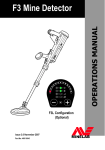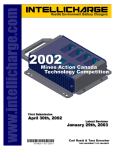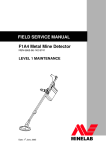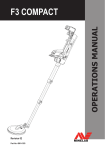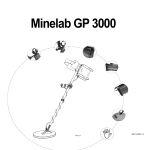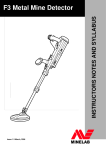Download Minelab F1A4 Specifications
Transcript
OPERATOR INSTRUCTORS NOTES AND SYLLABUS F1A4 Metal Mine Detector st Issue: 1 June, 2005 1 SLIDE F1A4 Operator Instructor Notes and Syllabus DESCRIPTION INSTRUCTORS NOTES These Instructor Notes are produced to assist instructors in preparing for the F1A4 Operator Training Course. They are provided as a guide and are not intended to be prescriptive. They should be used in combination with the information contained in the F1A4 Operations Manual and Field Guide. Personnel attending the course will be required to pass an Evaluation to qualify as a proficient operator on the equipment. One INTRODUCTION The instructor will provide a short welcome and brief the students on the course. This can include some background information on the Minelab F1A4. Students will complete course registration administration as required. If applicable, students will be asked to stand and introduce themselves to include a short description of any experience in demining. Students will be organized into pairs and issued an F1A4 per pair (or one per student if numbers permit). Two COURSE OUTLINE The Minelab F1A4 Operator Training Course includes lectures and practical sessions. The course is conducted over two to three days (depending on student numbers and language translation requirements) and consists of the following lessons: • Introduction • LESSON 1 – Description of the F1A4 • LESSON 2 – Assembly of the F1A4 • LESSON 3 – Principle of Operation • LESSON 4 – Operation of the F1A4 • LESSON 5 – Operator Maintenance and Care • Operator Evaluation Minelab Countermine Division Safety through Excellence 2 SLIDE Three F1A4 Operator Instructor Notes and Syllabus DESCRIPTION LESSON 1 – DESCRIPTION OF THE F1A4 Aim. Correctly describe and identify the F1A4. Classroom Instruction. The training aids required are: Chalk board or white board. F1A4 Training PowerPoint Presentation. One F1A4 in its Compact Bag inside the Hard Case. F1A4 detectors - one per two students. The major teaching points of this lesson are as follows: Safety. Equipment specifications. Description of all F1A4 components. TEACHING POINTS Three Four Safety. Emphasize the need to become very familiar with the equipment and the need to be able to identify all parts. Relate this to safety issues during the demining process. All components should be checked for correct operation before using the equipment. If a fault develops, an operator must be able to correctly name the faulty part of the detector. Explain the importance of the Test Piece. Equipment Specifications. List the basic specifications for the F1A4. Explain that the Control Box is not waterproof, but water resistant. All other parts of the detector are waterproof including the Coil. Explain the need to use good quality alkaline batteries and not carbon batteries. Five Description of the Compact Bag and Hard Case. Using the Compact Bag and Hard Case cover the following points: • Rugged zippered Compact Bag, protected when closed • Tear resistant cordura material in Compact Bag • Reinforcement to protect Coil when packed • Ease of adjusting the shoulder strap • Ability to stack transport cases • Ability to lock latches • Avoid sitting on transport cases • Hard Transport Case is designed to protect the F1A4 during transit • It is recommended to keep the F1A4 secured in the Hard Case when not in use. Minelab Countermine Division Safety through Excellence 3 Six F1A4 Operator Instructor Notes and Syllabus Main Components Using the assembled detector identify the following components. Avoid giving detailed descriptions of the function of each component, as this will be covered in Lesson 4. Arm Rest. Designed to ensure a comfortable fit for the operator’s arm and adjustable when fitted to the detector. Note the strength of the material. Upper shaft. Identify Upper shaft pointing out: • Made of aluminium for ruggedness. • Upper and Lower Camlocks (both different internal components). • Ability to slide and lock Handle up and down. Handle. Designed for comfort. Note Hand Strap to add further ease of use when operating the detector. Foam Handgrip is easily replaced and absorbs sweat in hot climates. Includes a Camlock for locking onto the Upper shaft and is adjustable to various arm lengths. Made of glass filled nylon and is very tough. Identify the Locking Pin for connection of Control Box to the students. Lower Shaft. Explain that Lower Shaft cannot contain any metal components and is made of glass filled nylon. Identify: • Yoke. • Nut, Bolt and Friction Washers. • Cable groove to protect cable when in use. Seven Coil and Cable. Referring to the slide showing a photo of a training monoloop Coil. It is important to mention that part of the F1A4’s superior capability is due to its Coil design. Give a brief description on the monoloop coil design explaining that no separate transmission and reception windings exist, just one winding performing both roles. Emphasize that the closed Coil stops vegetation from sticking up between any potential gaps and adds to the toughness of the design. Other points: • Waterproof design. • Strain relief. • Design permits edge detection (explained in Lesson 4). • Extremely tough. • Cable connector – explain, as with any electrical piece of equipment, the connector is the weakest link. Minelab Countermine Division Safety through Excellence 4 Eight F1A4 Operator Instructor Notes and Syllabus Skid Plate. The Skid Plate provides protection for the Coil. It has no effect on the sensitivity of the Coil even when wet and is easy to replace. Earsets. Identify where the Earsets are stowed in the Compact Bag. Demonstrate attachment to ear. Emphasize: • Comfort and durability. • Ease of fit underneath helmet. • Military connector for connection to Control Box. • Strength of Earset cable. • Ease of clipping earphone back into moulding if required. • Various earsets are available: o Earset Speaker On which (when connected) allows the F1A4’s Loudspeaker to continue to operate (for humanitarian demining). o Earset Speaker Off, identifiable by a short length of green heatshrink on the cable, shuts the detector Loudspeaker off when connected. o Both Earset above are also available with an in-built volume control. Batteries. The F1A4 comes with four ‘D’ cell batteries as standard, either Alkaline or Rechargeable. Test Piece. The Test Piece is used to simulate the sound of a Type 72A minimum metal mine buried to a depth of 15 cm. The Test Piece is a vital piece of equipment to ascertain whether the F1A4 is working to its optimum performance. Make sure the Test Piece is carried by each deminer on their person. Nine Control Box. Key points: • Houses all electronics, batteries and controls. • Is IP65 water-resistant. • Includes Battery Lid and Battery Carrier. • Identify all buttons, switches and ID Plate. • Identify Battery Lid locking pins. • Identify RS232 port. • Internal Loudspeaker. • Should always be handled with care. Minelab Countermine Division Safety through Excellence 5 Ten F1A4 Operator Instructor Notes and Syllabus Stowing the detector. Use the packed Compact (carry) Bag to indicate the locations of the stowed F1A4 components. Mention the following: • Check for damage/cleanliness. • Have students be able to name each item. • Stow away correctly. Other Components. • • • Eleven Operations Manual – waterproof paper. Field guide – abbreviated and pictorial instructions, waterproof. Control Box Bag – shoulder straps and belt clips. QUESTIONS Students shall be able to correctly identify all components of the F1A4. Minelab Countermine Division Safety through Excellence 6 SLIDE Twelve F1A4 Operator Instructor Notes and Syllabus DESCRIPTION LESSON 2 – ASSEMBLY OF THE F1A4 Aim. Correctly assemble and disassemble the F1A4. Classroom instruction. The training aids required are: Chalk or white board. F1A4 Training PowerPoint Presentation. F1A4 detectors - one per pair of students (minimum). One set (four size “D” cells) of fresh batteries per F1A4. The major teaching points of this lesson are as follows: Review. Assembly and disassembly of the F1A4. TEACHING POINTS Review. Review the description and identification of components of the F1A4. Thirteen Shaft Assembly. Using a packed F1A4 demonstrate the Shaft assembly procedure in the following manner: • Secure the Handle. As you take the F1A4 out of the Compact Bag secure the Handle in one place by locking the Handle Camlock. This will prevent it from sliding up and down the Upper shaft while you are presenting. • Orient Shafts. Ensure that the cable is completely embedded in the Lower Shaft cable guide (demonstrate this by using all four fingers of your right hand feeling the cable as they run up the length of the Lower Shaft) and that excess cable is not protruding between the Lower and Upper shafts. Place the Coil on the ground and gently hold in position using a foot. When orienting the shafts ensure the Coil is facing forward on the Lower Shaft and the Handle is facing forward on the Upper shaft. • Unlock Lower Camlock. • Prior to connecting the shafts once again ensure that the Cable is securely in the guide. • Connect Shafts. • Lock Lower Camlock. Minelab Countermine Division Safety through Excellence 7 • Fourteen • • • F1A4 Operator Instructor Notes and Syllabus Secure Grommet. Show both Grommets and explain the reason for their existence (reduces stress on cable) and ability to shaft or hip mount the Control Box. Stress the importance of the selected Grommet being properly locked into the Keyway opening located at the top of the Upper shaft. Unlock Upper Camlock. Insert Armrest. Explain the correct orientation needed to ensure the cable does not interfere with the insertion of the Armrest. Demonstrate how the Armrest can be adjusted. Lock Upper Camlock. Conduct final check to ensure Grommet is correctly located. Fifteen Present to the students the difference in ‘hip mounting’ the Control Box by using the Lower Grommet on the Coil cable. Follow the same procedure for ‘shaft mounting’ the Control Box as discussed above. Sixteen Battery Installation. Using the 4 ‘D’ Cell Batteries demonstrate the correct procedure for inserting batteries. Note the following: • Control Box should be placed in the Compact bag when fitting/removing batteries (stops dirt and debris from getting on Control Box). • The batteries should be inserted from the centre outwards in accordance with the Battery Map. • The batteries should be gently placed inside the Battery Carrier and not forced. • The negative end (flat end) of the battery should be inserted first. • There is no need to remove the Battery Carrier from the Control Box when inserting batteries. • Demonstrate the ease with which to lock the Battery Lid Clips into place (they should not be forced). Seventeen Connection of the Control Box to the Upper shaft. Demonstrate the correct attachment of the Control Box to the Upper shaft ensuring that the Locking Pin is turned all the way to the stop. Eighteen Connection of the Coil Cable and Earset to Control Box. Connect the Cable Connector and Earset to the Control Box ensuring: • Both connectors ‘click’ into the locked position. • Ensure both Cable Connectors are held by their base when connecting and disconnecting. Once assembled, adjustments can be made to the handle to ensure the weight of the detector is balanced evenly as the detector is swept from side to side. Minelab Countermine Division Safety through Excellence 8 Nineteen F1A4 Operator Instructor Notes and Syllabus Disassembly. Reverse the procedure to demonstrate disassembly. While disassembling place each component back into the Compact Bag paying particular attention to the: • Correct location of each component as shown on the reverse side of the field guide. • Yellow alignment line in the base of the Compact Bag to illustrate the correct orientation of the handle. • Correct folding of the Upper and Lower Shaft to fit properly into the Compact Bag (this may take several demonstrations) – Upper and Lower Shaft Camlocks are to be locked but the Handle Camlock unlocked. • Need to remove the batteries from the Control Box. • Replacement of Dust Caps as required. • Test Piece being correctly stowed into the Control Box Bag. Have the students take turns assembling and disassembling and watch for incorrect procedures. Alternatively, select one student to assemble the detector with the rest of the class reporting faults as they occur. The same method can be used for disassembly. Twenty QUESTIONS Students shall be able to correctly assemble and disassemble the detector with no faults. Faults to check for include: • Incorrect alignment of Shafts. • Failure to unlock a Camlock when trying to insert or remove the Shaft or Armrest. • Incorrect positioning of Grommet. • Incorrect method of inserting batteries into the Battery Carrier. • Failure to turn the Handle Locking Pin to the locked position. • Failure to “click” Coil Connector into the locked position. • Incorrect folding of Shafts before placement inside the Compact Bag. • Failure to place the Test Piece back into the Control Box Bag. Minelab Countermine Division Safety through Excellence 9 SLIDE Twenty one F1A4 Operator Instructor Notes and Syllabus DESCRIPTION LESSON 3 – PRINCIPLE OF OPERATION Aim. To understand the principle of metal detection and how Multi-Period Sensing (MPS) eliminates false alarms generated from mineralized ground. Classroom instruction. The instructor must decide whether the content of this lesson is applicable for the student group. The training aids required are: Chalk board or white board. F1A4 detectors - one per pair of students (minimum). One set (four “D” cells) of fresh batteries. Two different types of mineralized rock (laterite if available). F1A4 Training PowerPoint Presentation. The major teaching points of this lesson are as follows: Revision. Principle of Operation. Multi Period Sensing. Demonstration of Ground Balancing. TEACHING POINTS Revision. Nominate selected students to assemble and disassemble the F1A4 in front of the class. Twenty two Twenty three Principle of Operation. Using the slides, explain the principle of metal detection. Emphasize: • All detectors use the same magnetic principle to detect metal. • The smaller the target the more difficult to obtain a response. • Where the ground is mineralized, the false alarm can hide a minimum metal mine. • Conventional detectors must reduce sensitivity to combat the effects of ground. • Reducing the sensitivity of a detector increases the risk of not detecting a minimum metal mine. • The F1A4 has no sensitivity adjustment as it can maintain maximum sensitivity even when working in heavily mineralized soil. Minelab Countermine Division Safety through Excellence 10 Twenty four F1A4 Operator Instructor Notes and Syllabus Multi Period Sensing. The F1A4 uses three channels in its electronics comprising two target channels and one ground channel. MPS successfully and easily detects the presence of mineralized ground and ignores its effects. MPS can be a difficult concept to explain. It is recommended that instructors make best use of PowerPoint presentation. MPS produces a series of wide and narrow pulses that are transmitted into the ground from the Monoloop. Note: it is a physics law that the electromagnetic radiation will also transmit upwards in the opposite direction. That is why there can be no metal in the Lower Shaft assembly. Twenty five After each pulse, both wide and narrow, a piece of metal in the ground will be “excited” and will return its own radiation as a decay pattern as shown. Minelab Countermine Division Safety through Excellence 11 F1A4 Operator Instructor Notes and Syllabus Twenty six Twenty seven If the ground is mineralized, the ground will also provide a response after each pulse that will also decay over time. In conventional detectors, the interference from the ground cannot be removed unless the sensitivity of the detector is decreased. Twenty eight Demonstration of Ground Balance. The best method is to use a “mineralized rock” to demonstrate the false alarm as follows (Note: a mineralized rock that the detector has not been balanced to is required): • Without the mineralized rock, use the Test Piece (or some minimum metal mine fuse/firing pin) to demonstrate the soft response from the detector. • Holding the metal target under the mineralized rock, pass both under the Coil. The response from the mineralized rock should mask the target (this will not happen if the target is a large piece of metal as the response to that will be louder). • Remove the target and pass only the mineralized rock under the Coil to show that the response remains the same as before. • Carry out the ground balancing procedure (do not go into detail as this is explained in Lesson 4) – note the response from the mineralized rock disappears. • Pass the mineralized rock under the Coil to show there is now no response. • Place the target under the mineralized rock and pass it under the Coil – only a response from the target will be audible. Note: If this demonstration is conducted inside a classroom, electrical interference from lights, air conditioners etc may cause a warbling noise from the detector. If this happens complete the Noise Cancel procedure to reduce/eliminate the interference. If this does not work, the demonstration may have to be conducted outside in a location away from electrical power sources. Twenty nine QUESTIONS Students shall be able to explain the principles of metal detection and MPS technology. Minelab Countermine Division Safety through Excellence 12 SLIDE Thirty F1A4 Operator Instructor Notes and Syllabus DESCRIPTION LESSON 4 – OPERATION OF THE F1A4 Aim. To understand how to operate the F1A4. Classroom instruction followed by an outdoors practical exercise with students working in pairs locating previously buried targets in a designated area. The training aids are: Classroom: Chalk board or white board. F1A4 detectors - one per pair of students (minimum). One set (four “D” cells) of fresh batteries. Mineralized rock (laterite if available). F1A4 Training PowerPoint Presentation. Outdoor Area (See layout at the end of these notes): An outdoor area suitable for the burial of targets, confirm that the area is free of metallic contamination, and large enough to accommodate the size of the class. F1A4 detectors - one per pair of students. One set (four size “D” cells) of fresh F1A4 detector. Variety of targets (inert AP and AT mines) buried in a previously cleared area (typically 2m x 3m area). Location disks/flags to mark detected targets. One set (4 x ‘D’ cells) of weak batteries (to demonstrate ‘Battery Low’). The major teaching points of this lesson are: Revision. Control Box Operation. All procedures. F1A4 Field Guide. Pinpointing Targets –Edge Detection. Operating Multiple Detectors. TEACHING POINTS Revision: • • • Select a student to explain the principle of metal detection (if applicable). Select a student to explain MPS (if applicable). Select a student to assemble the detector from the Compact Bag. Minelab Countermine Division Safety through Excellence 13 Thirty one F1A4 Operator Instructor Notes and Syllabus Control Box Operation. Have the students unpack the Control Box from the bag and follow the demonstration while looking at the Control Box. Explain the function of each Control Box switch and button. Key points to note are: • • • • • • Thirty two The Ground Balance Switch must be held in Balance position throughout the Ground Balance procedure. There must be no metal under the Coil when conducting Ground Balance. The detector must be held perfectly still when conducting Noise Cancel. There must be no metallic objects near the Coil during Noise Cancel. When the Battery Low alarm sounds, batteries should be immediately changed (demonstrate ‘Battery Low’ alarm with a set of weak batteries). The F1A4 uses a Threshold Tone that provides a very soft tone to provide a positive indication to the operator that the detector is working correctly – the Threshold Tone also assists the operator in distinguishing tone changes caused by a small target. Normal Procedures. Using the Field Guide, demonstrate the Normal Procedures (switch on and Ground Balance). Key points: • During the six seconds start up, internal diagnostic checks occur, previous Ground Balance and Noise Cancel settings are loaded and no detection is possible. • When conducting Ground Balance: o The Coil needs to be raised 10 cm from the ground. o Each complete up and down movement should occur over 3-4 seconds. o The Coil should be kept horizontal to the ground during the up and down movement. o Continue with the up and down movement until all ground interference is removed. o If the alleged ground interference does not reduce, it is likely that the Coil is trying to Ground Balance a piece of metal – select another area to Ground Balance. o Once a Ground Balance procedure has been completed, the detector will remember those Ground Balance settings even after it is switched off and on again. Thirty three Optional Procedures. Using the Field guide demonstrate the Optional Noise Cancel and Audio Reset procedures: Key points: • Noise Cancel o During Noise Cancel it is important to keep the detector still – during this procedure the F1A4 electronics scans the environment over 4000 frequencies to search for and record all sources of interference – once Minelab Countermine Division Safety through Excellence 14 • Thirty four F1A4 Operator Instructor Notes and Syllabus completed the F1A4 will select the frequency band with the least interference. o There must be no metallic objects near the Coil during Noise Cancel. Audio Reset o Field experience shows that Audio Reset is rarely required, although this procedure can be used to “re-acquaint” an operator’s ear to the threshold tone, especially during training. Critical Safety Procedure. Using the Field guide, demonstrate use of the Test Piece and Sweeping procedure. Key Points: • Using the Test Piece is a critical procedure that MUST be done before any demining is conducted and every time the detector is switched on. • The soft sound of the Test Piece demonstrates what the sound of a minimum metal mine at depth will sound like. • When sweeping, the Coil must remain horizontal to the ground at all times. • When the ‘Battery Low’ alarm is heard, the detector must be switched off immediately and fresh batteries fitted. The red LED on the Control Box front panel flashes and the detector emits a loud oscillating tone when the charge in the batteries drops to a predefined, low level. There is no loss of sensitivity or capability before the LED flashes or the audible tone is heard. Use the Field Guide, and through question and answer, review the preceding procedures. Thirty five Pinpointing Targets – Sweeping Key points: • While sweeping the Coil it is important to keep it parallel to and at a constant height from the ground at all times. • Be aware to any tendency amongst the students to raise the Coil at the ends of each sweep, this will reduce detection depth. • Each sweep of the Coil should overlap the area covered by the previous sweep to ensure full coverage of the area being searched. Thirty six Pinpointing Targets - Edge Detection. Pinpointing with the F1A4 is very accurate due to the geometry of the Monoloop Coil. Because detection occurs over the entire Coil surface, “edge detection” can be used. Explain the F1A4 Coil geometry. Key points: • The cylindrical shaped F1A4 detection pattern remains constant at depth therefore an operator is clearing the same amount of area at depth as he sees on the surface (note: conventional detectors have a conical shape). • Edge detection makes the detection of targets up against walls and fences possible. Minelab Countermine Division Safety through Excellence 15 Thirty seven F1A4 Operator Instructor Notes and Syllabus Pinpointing Targets - Edge Detection – Pinpointing Small Targets Key points: • Explain to the students that when a possible target has been located continue to sweep the Coil over the location, but reduce the size of the sweeps to more accurately determine the position of the target. • To further pinpoint the location, sweep the Coil across the ground and advance forward towards the target with a half Coil diameter overlap on each sweep. Notice when the target signal is first heard – this determines the edge of the target area. • Advance another sweep distance and approach the Coil from each side. Notice when the target signal is first heard – this will indicate the side boundaries of the target area. Thirty eight Pinpointing Targets - Edge Detection – Large or Multiple Targets Step 1 Note Use the PowerPoint Presentation to explain the technique of edge detection and mapping against multiple and large targets. Note that this will be demonstrated in the outdoor area but should first be explained in the classroom. When large or multiple targets are found it may be difficult to define the target by using the crossing method as discussed in the previous slide. It is therefore recommended that the following procedure be used to define large or multiple targets: • Start high and pass the Coil over the target at ever decreasing heights until you get an indication of the main centre (or centres) of the metallic mass. Thirty nine Pinpointing Targets - Edge Detection – Large or Multiple Targets Step 2 • Forty At normal search height, move the Coil from outside the detection zone directly towards the centre of the mass, and note where a clear detection signal is heard. Pinpointing Targets - Edge Detection – Large or Multiple Targets Step 3 • Forty one Repeat the process in Step 2 at small intervals around the whole target to provide an outline of the shape of the target. Pinpointing Targets - Edge Detection – Large or Multiple Targets Step 4 • Listen for indications of tone pitch. This may indicate multiple targets or booby traps. Minelab Countermine Division Safety through Excellence 16 Forty two Detector Tones • • Forty three F1A4 Operator Instructor Notes and Syllabus Threshold Tone. A low volume continuous tone indicating correct operation of the detector. Target Tone. Abrupt variation to the volume and pitch. Operating Multiple Detectors Key points: • When two or more F1A4 detectors are operating in close proximity it is necessary to automatically tune each unit via the Noise Cancel procedure to set the operating frequencies so that signals do not interfere with each other. • To set up multiple detectors it is necessary to adhere to the following procedure: o Turn ‘Detector 1’ On, and switch to Search. Wait for the end of the Startup tone. o With ‘Detector 1’ operational, position ‘Detector 2’ two metres away and turn it On. Wait for the end of the start-up tones and then perform a Noise Cancel procedure. Wait 70 seconds for the Noise Cancel to end with the four ‘beeps’. o With ‘Detector 1’ and ‘Detector 2’ both operational, position ‘Detector 3’ two metres away and turn it On. Wait for the end of the start-up tones and then perform the Noise Cancel procedure. Wait 70 seconds for the Noise Cancel to end with the four ‘beeps’. o Continue the above procedure if more that three detectors are to be used in close proximity. • The recommended minimum operating distance between units is three metres, but if interference does result it will be necessary to limit the number of detectors in use or increase the distance between units. SOP Safety distances rather than interference distance normally dictate the distance between operational detectors. Forty four QUESTIONS Outdoor Area. At the completion of the classroom lessons move to the outdoor training area previously prepared. Provide practical demonstrations of all of the procedures contained in the lesson. Also demonstrate edge detection. Note: by selecting different targets, demonstrate how a different tone is produced for each target. Often, different coins (containing different metals) are the best way to demonstrate this. Students shall be able to explain all operating procedures. Students shall be able to locate and identify the approximate size and depth of buried targets. Students shall use correct sweeping methods to pinpoint the targets. Minelab Countermine Division Safety through Excellence 17 SLIDE Forty five F1A4 Operator Instructor Notes and Syllabus DESCRIPTION LESSON 5 – OPERATOR MAINTENANCE AND CARE Aim. To understand how to care for and maintain the F1A4 detector. Classroom instruction. The training aids are as follows: F1A4 Training PowerPoint Presentation. F1A4 detectors - one per pair of students, and one per instructor. Clean wipe cloth, one per instructor and student. The major teaching points of this lesson are: Revision. Care of the F1A4 Detector. Replacing the Skid Plate. TEACHING POINTS Revision. Revise student on: • Specifications of the equipment. • Functions of Control Box controls. • Description of operating procedures. Forty six Care of the F1A4 Detector Discuss the points covered in the relevant PowerPoint slide. Disassembly of the detector and its stowage in the Compact Bag is also part of this lesson. Key Points: • Inspect for damage before cleaning and disassembly and report faults if required. • Use a clean cloth and no solvents (mild soap or detergent only). • Ensure disassembly and stowage is correct as given in Lesson 2. • Dust Caps should be clean and placed over exposed connectors. Forty seven Fitting the Skid Plate Demonstrate how to replace the Skid Plate. Key Points: • Place Skid Plate on ground. • Place Coil onto Skid Plate. • Using light foot pressure press Coil into Skid Plate (avoid excessive pressure). • Water inside the Skid Plate will not affect sensitivity. • The Skid Plate need not be removed for cleaning at the end of each day’s operation unless the Coil became wet. Minelab Countermine Division Safety through Excellence 18 Forty eight F1A4 Operator Instructor Notes and Syllabus QUESTIONS At the end of this period of instruction the student shall be able to carry out operator care and maintenance and correctly stow the equipment in the Compact Bag and the Transport Case. Minelab Countermine Division Safety through Excellence 19 F1A4 Operator Instructor Notes and Syllabus OUTDOOR TRAINING At the completion of the classroom instruction it is important that all students have a sufficient amount of time to demonstrate proficiency in an outdoor environment with the F1A4. It is recommended that this be done over two full days however depending on time available the least amount of time to be allocated should be no less than one full day. It is recommended that the outdoor training be conducted in purposely prepared training lanes and that there be enough lanes for two students per lane. Each lane should be one metre wide and ten metres long and the lanes should have a separation of at least ten metres. It is also very important that the lanes be free from metal contamination prior to laying any training targets. Although the F1A4 is capable of cancelling the electronic influence created by another detector as close as three metres away and still operate to its full capability, a ten metre separation between detectors is suggested and a metal-free area to provide the best training environment. This will ensure that those students with no experience will understand how to operate the detector and recognize its responses before needing to deal with a complicated environment. Training lanes should be different from each other offering a range of challenging targets. Differing the targets in each lane allows the paired students to move between lanes during the training. Simulated targets should represent the widest range of targets presently found in minefields around the world and not necessarily those you anticipate will be found in your next area of operations. While the students are practicing in their lanes you and your training staff should be moving between each group providing feedback from your experience in the use of the F1A4. No doubt during your training day you will stop every hour or so to allow your students to take a break. Each time the students return from their break gather the class together and provide group instruction on one of the following topics: • Ground Balance. This is always impressive. If the soil in the training area is benign, prepare ahead of time and seek some mineralized soil from the local area or a local brick manufacturer or distributor. Fired clay roof tiles work very well. Show the class the reaction from the F1A4 when passed over this then conduct the Ground Balance (GROUND BALANCE) function. Repeat this process with a target laid under the mineralized rock. It is likely that you will be asked if it is possible to GROUND BALANCE out a metal target. The fact is that it is possible to GROUND BALANCE a very small target in very heavily mineralized soil. Try it yourself with your mineralized rock and an inert M14 or equivalent inert mine. It is most unlikely that bigger targets in benign soil can be balanced out. Minelab does not advocate the drill that an operator can try to balance out a potential target in a mine lane as proof it is actual metal. However, if a small target was Ground Balanced then it should be obvious to an operator when the Coil is moved away from the target. There should be an alarm from the surrounding soil because it is no longer balanced on the soil rather on the small concealed target. Make sure there are no misunderstandings about this. • Test Piece Procedure. Exactly as shown in the Field Guide and the Operations Manual. • Pinpointing. Minelab detectors pinpoint their targets in a different way to all other detectors and if your students have used another detector then it is important that the correct procedure for pinpointing is taught and adopted by the students. Get used to the pinpointing procedure taught in Lesson Four of this Training Program. When teaching the application of ‘Mapping the Target’ ensure that you and your students stop Coil movement toward the target as soon as the slightest change is heard in the tone. Move the Coil backwards and forwards to confirm that you have actually noted the point of tonal change. Note that point on the ground and carry out this procedure for each of the 12 radius of a clock until you have a sound impression of the shape of the target. If it is a circle then ask the student to pick the actual centre of the circle and dig for your target. The more experience you and your students gain in this process the better you will become Minelab Countermine Division Safety through Excellence 20 F1A4 Operator Instructor Notes and Syllabus at picking the exact centre of your target. If you have an odd shaped target it may have two centres or be a pipe. You should still be able to pick the centre of the mass. • Two targets resolution. Your aim here is to show how to map two targets laid within close proximity to each other showing the actual shape on the ground of the dual targets. Use the pinpointing procedure mentioned above. • Similar looking targets but opposite tones. Use two coins that look similar but react differently to each other. This is to demonstrate how the tones can provide some information about target conductivity. For example the coins, although they look the same, are different in composition. In Rwanda they use this feature to identify specific mines. A VS50 sounds much different than a Type 72. Again it is not fool proof, but when combined with local experience it is a useful capability for the operator. • Large Target. When you have a large metal target such as a metal anti-tank mine the extreme edge of detection will appear to be very large and in fact it is a long way from the outer edge of the target let alone the centre of it. To help you find the centre of large targets you can use the following technique. Hold the detector by the handle at 90° to the ground and at chest height. Lower the Coil towards the ground directly above the area you believe to be the centre of the target. Slowly reduce the height of the Coil towards the ground until you hear the first sign of a response in the Earset. After receiving this initial response you can then move the Coil around this general area, keeping it at the same height, to ascertain the centre by listening for slight fluctuations in the pitch of the tone. From these changes in pitch you will quickly ascertain where you believe the centre of the target mass is. • Water. Dig a hole and fill it with water (or use a plastic bucket without a metal handle) and show the F1A4 is not affected by operating in a wet environment. Place a target in the bottom of the hole or under the bucket and show your students that there is no loss of sensitivity. • Soil sifting. The Monoloop Coil offers an excellent benefit when searching an area for a target, which you anticipate to be fragmentation. Rest the Coil on a known clean piece of ground close to the area to be excavated. As you remove soil from the area place that soil onto the Coil and wait for a response. If no response occurs, brush the soil off and do it again with another sample. When presenting this instruction make sure you have put a small piece of metal in the area to be excavated. Initially, show the students the detector alarming on a target in the ground then proceed to find it using this process. Piece of wire. Have available a piece of wire that can show the students the conductivity of a target. The wire needs to be about 60cm long and quite thin. Firstly ask the class if they believe that a metal piece of wire will make the detector alarm, some will say yes. Holding the wire out straight, pass it over the Coil. It will not make a sound. Join the wire together into a figure of eight and pass it across the Coil again. It will now alarm with a moderate volume level. Unwind it from the figure of eight and turn it into one circle and pass that across the Coil. This will provide you with the strongest response. Now turn the circular piece of wire at 90 degrees to the Coil and note that the response is weaker. This demonstration shows that a given mass of metal will have differing levels of detection depending on its shape. Damaged or corroded mines may detect differently depending on the extent of damage or corrosion, or the way they lie in the ground. Minelab Countermine Division Safety through Excellence 21 F1A4 Operator Instructor Notes and Syllabus OPERATOR CONFIRMATION EXERCISE The Operator Confirmation Exercise is used to confirm all training objectives for the course. Instructors can decide to what degree the exercise can take. For example, it can include a theory evaluation with oral questions being given to the student. However, as a minimum each operator must demonstrate proficiency in the use of the detector by entering a previously prepared test area. For an operator to be deemed proficient, all targets within the test area must be detected. If a student fails to detect all targets, he should be permitted to attempt the Confirmation Exercise as many times as necessary in order to pass. An example of an Operator Confirmation Exercise Sheet is included at the end of these Instructor Notes. Equipment • • Cleared evaluation area – constructed as one mine lane (1m wide and 5m long). Targets to bury in the test area as described below – if inert mines are not available, F1A4 Test Pieces buried at varying depths will suffice. Training As each student comes to be evaluated, make then go through the normal start-up procedures and also Ground Balance on your mineralized rock, brick or roof tile. They should then Ground Balance the detector as close as possible to the evaluation area. Earsets must be worn. • Sweeping drill. Ensure the students sweep with the Coil parallel to the ground, and as close as possible to the ground (observe local procedures) and that they overlap the front, rear and sides of the area by one half Coil width (100mm/4ins). In addition as they progress up the mine lane, they should advance the Coil one-half Coil width (100mm/4ins). When a target is initially detected, always sweep beyond the sound of the target to cleared ground before commencing pinpointing procedures. Minelab Countermine Division Safety through Excellence 22 F1A4 Operator Instructor Notes and Syllabus As a minimum, set up the lane as follows: E D C B A START POINT • A - Medium Size Target (PMA-2 det). A good strong tone so that they can demonstrate solid pinpointing technique. • B - Large and Small Target (PMA-2 and M14). Here they must demonstrate that they can actually detect two targets. Be careful to ensure that the students do not miss the smaller target by only recognizing a response from the larger target. The targets must be laid so that the small target can be heard. It is also a teaching point that the obvious target normally draws attention and an operator suddenly focuses on it forgetting it could be booby-trapped with a second mine. They must continue with their sweeping drill before investigating the target. Minelab Countermine Division Safety through Excellence 23 F1A4 Operator Instructor Notes and Syllabus • C - Three similar targets in star shape (three Test Pieces). This brings out the lesson that they must sweep forward to clear ground. Some will note the first two targets and forget the upper third one. The good operators will actually be able to state that there are three targets. That is an excellent response but all you should seek from this exercise is that the student can accurately map the “suspicious area” that they will investigate by prodding. • D - One large target right on the edge of the lane. conveniently located in the middle of lanes. • E - one small target (single Test Piece). Make as difficult as you want, but achievable. To prove that not all mines are The following is a suggested evaluation standard using inert mines – targets should be pinpointed to within 10 cm of centre: • T72a at 15cm (or similar minimum metal mine buried at maximum detection depth). • PMN or equivalent at 20cm. • Small different targets 10-15 cm apart. • Large metal anti-tank mine at 30 cm. • 2 small identical targets 7-10 cm apart. • Small anti-personnel mine near metal anti-tank. F1A4 OPERATOR PRACTICAL EVALUATION Name 1 Minelab Countermine Division 2 3 4 5 6 7 8 9 10 Remarks Safety through Excellence 24 F1A4 Operator Instructor Notes and Syllabus This is to certify that MINELAB F1A4 METAL MINE DETECTOR MINELAB ELECTRONICS PTY LTD Signed ………………… Minelab Countermine Division Dated: ………………… Safety through Excellence

























